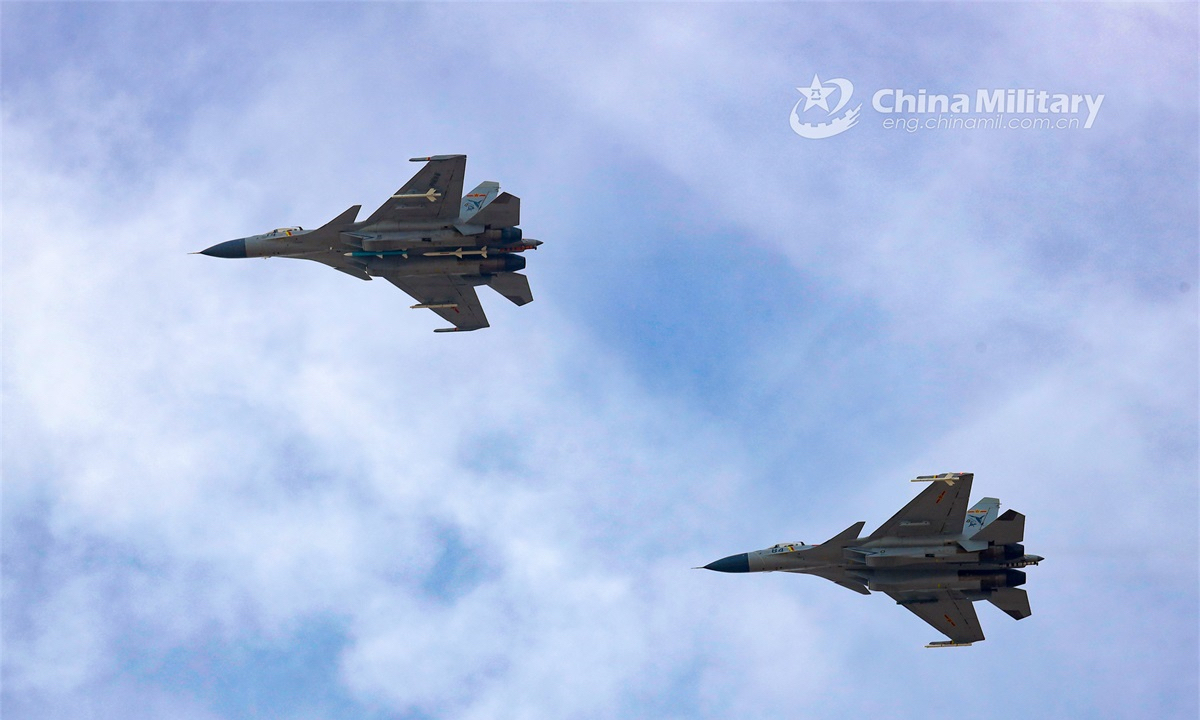
Carrier-based fighter jets attached to a regiment under the PLA Naval Aviation University fly in formation during a real combat flight training exercise on November 16, 2022. (eng.chinamil.com.cn/Photo by Ni Shuai)
China's carrier-based aviation force celebrated its 10th anniversary on Wednesday, with observers saying that the country's carrier-based warplane development and pilot training programs have entered the fast lane.
A celebration video China Central Television (CCTV) published on Wednesday gave a short glimpse of two types of aircraft that observers said could be China's new carrier-based fighter jets. One seems to be an upgraded version of the J-15 fighter jet, and the other the next-generation stealth fighter jet, reportedly called the J-35.
According to the clip, the upgraded version of the J-15 has an enhanced front landing gear compared with the current version of the J-15, which is expected to enable the aircraft to take advantage of catapults when it is deployed on China's third aircraft carrier, the
Fujian, which has electromagnetic launch and arrest devices, a Chinese military expert who requested anonymity told the Global Times on Wednesday.
The pitot tube is also missing on the new J-15, which is an indication that the aircraft has switched to use a more advanced active electronically scanned array radar system and associated avionics, giving it a much higher situational awareness and the capability to launch powerful missiles, including the highly agile PL-10 combat missile and the PL-15 beyond-visual-range missile, the expert said.
The clip showing the alleged J-35 stealth fighter jet
was first broadcast in February, with experts saying at the time that the next-generation aircraft is expected to operate together with the J-15 to maximize their combat capabilities, just like the US Navy's combination of the F-35C and the F/A-18E/F.
China is also developing carrier-based fixed-wing early warning aircraft and drones, in addition to more aircraft carriers,
CCTV reported in late April.
To meet the demands of its expanding aircraft carrier and carrier-based aircraft fleet, the Chinese People's Liberation Army (PLA) Navy has established the "cultivation mode" and "switch mode," with the former meaning training carrier-based pilots from scratch, and the latter meaning converting land-based pilots to carrier-based pilots.
These developments mean that the PLA Navy's carrier-based aviation force will soon receive more types of more advanced aircraft and expand significantly in size, becoming more powerful and comprehensive compared with 10 years ago when the country only had a single carrier with only J-15s, observers said.
The first carrier-based aviation force of the PLA Navy was established in a coastal region of the Bohai Sea on May 10, 2013, shortly after the J-15 carrier-based fighter jet for the first time took off and landed from China's first aircraft carrier, the Liaoning, in November 2012.
At a time when some people questioned if China could establish such a unit in a decade, the move marked a new addition to the main combat force of the PLA Navy in just a few months, realizing what people thought to be impossible, CCTV said.
A decade has passed, and the PLA Navy's two current carriers, the Liaoning and the Shandong, together with their onboard aviation forces, have honed their capabilities in far sea drills in the West Pacific, as they completed intensive sorties beyond the first island chain, dealing well with close-in reconnaissance attempts by foreign forces, according to media reports.
The PLA Navy has also started to recruit pilots among junior high school graduates, graduates of civilian universities, and women.




